Today, more and more homeowners are understanding how day-to-day activities like maintaining their property can have a lasting impact on nature. Eco-friendly roof cleaning techniques represent specific approaches aimed at maintaining the health of the environment while carrying out cleaning activities on your roof. Roof washing, like many other forms of cleaning, comes with its own set of difficulties. Most roof cleaning practices use methods that are extremely harsh and damaging not only to the roof but also to the vegetation, wildlife, and water bodies nearby. With the adoption of green cleaning methods, the negative impact associated with cleaning roofs can be greatly reduced.
In this blog, we will explore the four most eco-friendly roof cleaning methods and highlight sustainable practices that have less impact while maintaining your house. Focused DIY solutions for professional-grade cleaning as well as professional-grade cleaning available for use will be discussed so as to ensure that your roof is clean and safe for the environment at the same time.
Soft Washing with Biodegradable Cleaners: The Gentle But Effective Solution
The soft wash method of roof cleaning is by far the most effective and environmentally friendly option of all eco-friendly roof cleaning methods. To get rid of dirt which includes moss, Algae and other debris which accumulates on the roof, the soft wash roof cleaning method procedure involves the use of low pressure water in combination with biodegradable roof cleaners.
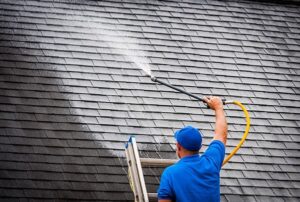
Benefits of Soft Washing with Biodegradable Cleaners:
- Soft on Roofs: Unlike high-pressure washing, which can damage shingles, tiles, and metal roofs, soft washing relies on low-pressure water to clean roofs without causing any harm.
- Toxic-Free and Safe: A non-toxic solution for cleaning the roof will serve its purpose without introducing chemicals into the environment, putting the house, plants, or water supply at risk.
- Prevents Future Growth: The biodegradable cleaners used in soft washing dissolve pre-existing organic growth such as moss, algae, and lichen, lowering the chances of regrowth and averting roof maintenance.
- Environmentally Safe: The use of biodegradable soft washing detergents that are safe for the environment reduces the ecological footprint during cleaning processes.
- Efficient Cleaning for Long-Term Maintenance: This cleaning technique helps remove roof contaminants and curb damage buildup, preserving the overall condition of the roof over time.
For people who want the best eco-friendly roof cleaning solution, soft roof cleaning is the best choice. Because it is safe and highly effective. It also guarantees clean, long lasting cleaning without any environmental damage.
Vinegar and Water Solution: A Simple, Natural Roof Cleaning Method
If you’re a homeowner looking for an eco-friendly roof cleaning approach, vinegar for roof cleaning is a great option. This do-it-yourself (DIY), Eco-friendly cleaning method is simple and cost-effective, making it perfect for anyone who wants to get rid of moss and algae on their roofs without chemicals. The solution is simply a mix of water and white vinegar, thus making a cleaner that’s safe for your roof.
There are many advantages to using vinegar on your roof, especially if you are considering a natural roof-cleaning treatment. Vinegar can destroy the organic moss and algae, and because it breaks down the organic material instead of burning it, your roof is safe.
Benefits of Using Vinegar and Water for Roof Cleaning:
- Non-Toxic: The cleaning solution does not contain chemicals, meaning it is safe for your roof and the environment.
- Affordable: Because vinegar is cheap and accessible, it can be used by homeowners who are working with a budget.
- Safe for Asphalt and Tile Roofs: This method works best on asphalt and tile roofs, which are prone to moss and algae growth.
- Easy to Apply: Just combine vinegar with water in equal portions, apply it to the necessary regions, and wait for some time. It truly is quick and effortless.
- DIY Green Cleaner: In utilizing this DIY green vinegar cleaning technique, you are helping lower the negative effects of harmful chemicals on the natural world.
- Fights Moss and Algae: The vinegar solution is adept at killing and removing moss and algae so they do not continue to growth and build up.
Using vinegar may take multiple attempts when dealing with stubborn moss, but it is an exceptional and safe method for cleaning roofs because of its eco-friendly properties. It is optimal for those wanting to lower their carbon footprint while simultaneously keeping their roofs clean.
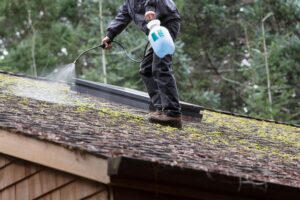
Hydrogen Peroxide Treatment: A Powerful, Chemical-Free Roof Cleaning Solution
For those eco-minded homeowners looking for an easy and effective cleaning solution, hydrogen peroxide eco-friendly roof cleaning is an ideal pick. This method contains no harsh chemicals as it functions with natural ingredients and bleach, getting rid of stains, moss, and even black streaks.
Hydrogen peroxide functions as a natural bleaching agent, getting rid of organic matter such as moss, algae, and black streaks on your roof. It changes these substances into oxygen and water, which means no harm to your roof or the environment.
Benefits of Hydrogen Peroxide for Roof Cleaning
- Efficient In Removing Algae On Roofs: One of the strongest advantages of hydrogen peroxide is that it greatly enhances the removal of algae on roofs as it destroys any growing algae, which can damage the roofing materials.
- Stain Removal: Hydrogen peroxide can assist in stain removal by serving as a natural bleaching agent – as in algae and moss stains.
- Works on Shingle and Metal Roofs: There are no limitations to where the treatment can be applied since it works on both shingle and metal roofs.
- Eco-Friendly: As a natural, biodegradable substance, the solution contains no chemicals, causing little ecological damage as a roof treatment.
Hydrogen peroxide is a popular option when dealing with eco-friendly roof cleaning options, since it efficiently cleans algae, moss, and stains, protects the roof; and preserves the environment.
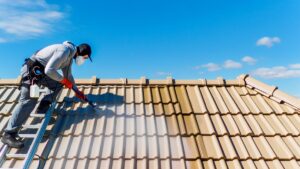
Manual Moss and Algae Removal: A Hands-On, Eco-Friendly Roof Cleaning Approach
For homeowners who want to make an eco-friendly roof cleaning, hand-cleaning roof moss is the best and most sustainable solution. This method involves scrubbing algae, moss, and debris with brushes and water while avoiding the use of harsh chemicals.
Benefits of Manual Moss and Algae Removal
- Chemical-Free: Environmentally friendly moss removal does not use toxic cleaners, unlike other methods, so it is safe for the roof and the environment.
- Safe for Roof Materials: Manually scrubbing roof tiles saves them from damage and deterioration associated with harsh chemicals and high-pressure water.
- Zero Environmental Impact: As no harmful substances are involved, like chemicals, animals and plant life, as well as water, remain unharmed.
- Labor-Intensive but Effective: Cleaning by hand takes more time, but on the upside, it’s the greenest and most eco-friendly cleaning method for your roof.
Cleaning your roof tiles by scrubbing them is perhaps the most responsible method one can use from an environmental standpoint, even if it is labor-intensive. It is ideal for those who wish to maintain sustainability and avoid chemicals. Yes, it takes extra work, but when it comes to protecting the environment by chemical-free washing, this method is a superb choice. Not only does it keep roofs clean and safe, but it’s also beneficial to the environment.
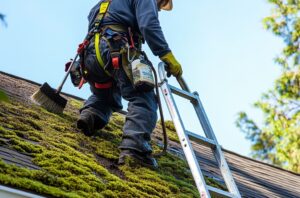
Comparing the 4 Eco-Friendly Roof Cleaning Methods
There are numerous techniques one can use to clean their roof. However, when it comes to Eco-friendly roof cleaning options, the method selected depends on how effective, safe, and economical it is. Therefore, we have designed a guide outlining five of the most sustainable roof cleaning methods for you to evaluate.
| Method | Effectiveness | Safety | Cost |
| Soft Wash | High | Very Safe | Moderate |
| Vinegar Solution | Moderate | Safe | Low |
| Hydrogen Peroxide | High | Safe | Low |
| Manual Scrubbing | Moderate | Very Safe | Low |
When considering the optimum eco-friendly roof cleaning approach, soft washing is regarded as the most effective despite its moderate cost. A more cost-effective and safe suggestion would be solutions made with vinegar or hydrogen peroxide. Alternatively, homeowners looking for an environmentally friendly approach may appreciate that manual scrubbing transforms roof cleaning into a costless, eco-friendly endeavor. It may be more labor-intensive, but it’s free from chemicals.
Conclusion
In conclusion, If you are looking for Eco-friendly roof cleaning options, Its is important to understand and choose the best green roof cleaning methods based on your roof’s needs and condition. We can say that soft washing is the most effective and sustainable eco-friendly roof cleaning solution. It ensures that your roof remains in top shape without causing any environmental impact. If the work is smaller or we have less severe cleaning tasks, DIY solutions like using vinegar or hydrogen peroxide is are excellent eco-friendly roof cleaning options.
However, seeking professional support is required for removing tough stains or more extensive cleaning. It helps to achieve the best results. For expert guidance and exceptional service in eco-friendly home maintenance, reach out to Referred Roof Cleaning today. Let our experts aid you in maintaining a clean, green roof with the most effective and sustainable solution.
FAQs
- What is the best eco-friendly roof cleaning method we should consider?
Soft washing is the best eco-friendly roof cleaning method as it uses low-pressure water and biodegradable cleaners to remove moss, algae and debris effectively while protecting the roof without any environment impact.
- How often should I clean my roof using these eco-friendly methods?
You should clean your roof minimum range of 1-3 years using eco-friendly roof cleaning methods. Because it prevents moss and algae building and also maintains roof health constantly.
- Are DIY eco-friendly cleaning methods as effective as professional services?
DIY methods like vinegar for roof moss are great for minor cleaning, but for tougher stains, professional services ensure a more thorough and lasting clean.
- Is vinegar a safe option for roof moss removal?
Yes, using a vinegar solution for moss removal is a safe, non-toxic, and eco-friendly roof cleaning method, especially effective on asphalt and tile roofs.
- Can manual scrubbing damage my roof?
No, manual scrubbing is a gentle and safe method that won’t damage your roof, making it an ideal eco-friendly roof cleaning option when done carefully.
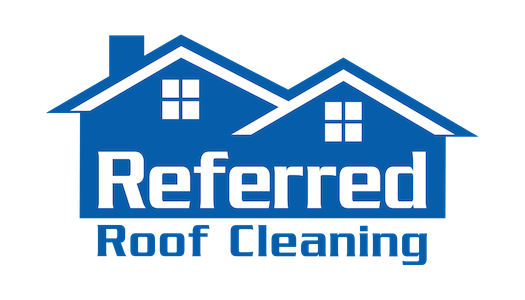
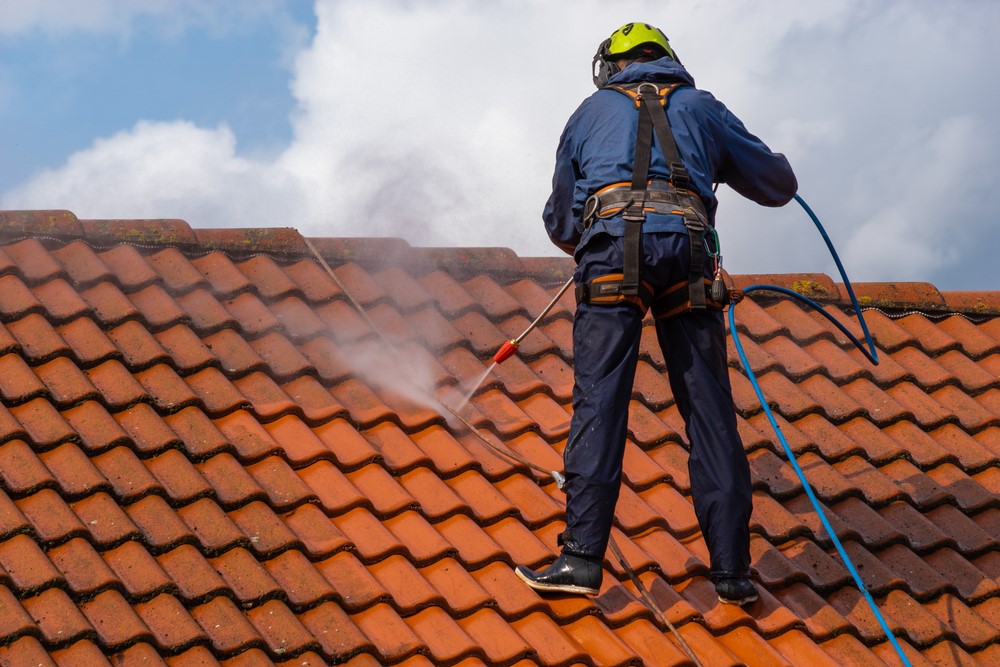
Recent Comments